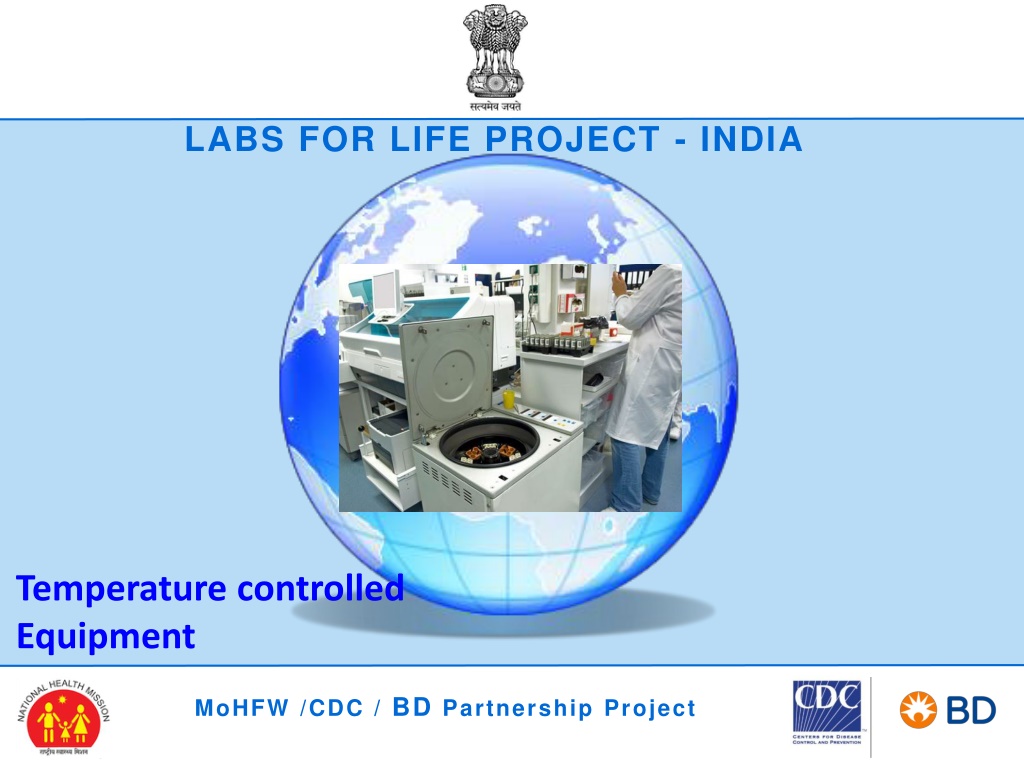Temperature Controlled Equipment in Laboratories - Usage and Safety Guidelines
Explore the essential temperature-controlled equipment like water baths and hot air ovens commonly used in laboratories, along with their proper usage and care guidelines. Learn about the significance of temperature monitoring, calibration of thermometers, and safety precautions while working with these equipment to ensure accurate results and user safety.
Download Presentation

Please find below an Image/Link to download the presentation.
The content on the website is provided AS IS for your information and personal use only. It may not be sold, licensed, or shared on other websites without obtaining consent from the author. Download presentation by click this link. If you encounter any issues during the download, it is possible that the publisher has removed the file from their server.
E N D
Presentation Transcript
LABS FOR LIFE PROJECT - INDIA Temperature controlled Equipment MoHFW /CDC / BD Partnership Project
Temperature controlled equipment Commonly used in Laboratories Water baths Hot air Ovens Refrigerators Freezers
Water Bath Water bath is used for carrying out reactions that require controlled temperature such as serological, agglutination and inactivation reactions in the Clinical Lab Water Bath is sometimes used to incubate samples in water at a constant temperature over a long period of time.
Use and care of a water bath 1. To avoid scaling, avoid hard water and use distilled water 2. Regularly addition of water helps replenish oxygen and maintain protective layers 3. Check that the temperature of water before use. 4. Water level should be above the level of liquid in tube 5. Use the lid to prevent loss of heat from the bath 6. Use capped tubes to avoid water enter the tubes. 7. Clean the water bath regularly 8. Any build up of scale can be removed by using 10% w/v citric acid and leaving it until the deposit has dissolved.
Temperature Monitoring: Using Thermometers Routinely monitoring performance The thermometer used must be calibrated Initial check must be at sufficient points to cover the expected working range followed by six monthly checks. Thermometer should be calibrated once a year. Check temperature at different points within the load period Continuous temperature monitors is recommended critical materials e.g. during sample transportation
Water bath - Safety Use the water bath exclusively with non- corrosive or non-flammable liquids. Use personal protective elements when working with the water bath Remember that the water bath is designed for use with a liquid inside the tank. If the inside is dry, the temperature of the tank can become very high Remember that liquids incubated in the water bath tank can produce burns if hands are inadvertently placed inside it.
Hot Air Oven Introduction Ovens are insulated chambers Circulating fans in oven help to distribute heat evenly throughout the chamber. Use of Oven: To dry glassware Sterilize metal and certain high temperature stable glass objects Recover palladium-covered alumina catalysts used in anaerobic chambers and jars
Good usage tips/practices Check for proper temperature before loading oven. Routine thermometer QC is a necessary control measure Recommended sterilization times: At 1600C, 60 min At 1700C, 40 min At 1800C, 20 min While loading the oven, start with the middle shelf. Leave air space around each item to allow proper heat circulation. If more space is needed, load other shelves, moving upward the middle. To avoid breakage, do not stack glassware.
Maintenance and Calibration Verification Maintenance Once every 6 months, clean the oven thoroughly after removing all interior parts Materials required for cleaning are soap, water, paper towels or rags. Calibration Verification Place calibrated thermometer on the middle shelf Switch the oven and adjust it to the desired temperature Check the thermometer every 15 min until the desired temp is reached Quality Control Record the oven temperature each time it is used
Safety Wear heat resistant gloves Do not place hot items on cold surface as the sudden change in temperature may cause breakage Remove items from the oven only once the temperature falls to 60oC. Do not place explosive, combustible or flammable materials in the oven Be careful of loose wires or connections.










































